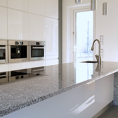The Ultimate Guide to Quartzite Countertops for Residential and Commercial Spaces

Quartzite is increasingly becoming a popular choice for countertops in both residential and commercial spaces due to its durability and the elegant aesthetic it offers. This guide explores why quartzite may be the perfect material for your next project.
What is Quartzite?
Definition and Formation: Explain that quartzite is a very hard metamorphic rock that originates as sandstone and transforms under intense heat and pressure.
Characteristics: Discuss the properties that make quartzite desirable, such as its hardness, which rivals that of granite, and its striking veining patterns that often resemble marble.
Benefits of Quartzite Countertops
Durability: Emphasize quartzite’s resistance to scratching and etching, making it suitable for high-traffic areas in both kitchens and commercial spaces.
Heat Resistance: Highlight quartzite’s ability to withstand high temperatures, making it ideal for environments where hot tools and cookware are used.
Aesthetic Appeal: Note the unique and luxurious appearance of quartzite, which can significantly enhance the look of a space.
Quartzite vs. Other Countertop Materials
Comparison with Granite and Marble: Provide a comparison to other popular materials like granite and marble, focusing on durability, maintenance, and cost.
Ideal Use Cases: Discuss where quartzite performs best compared to other materials in terms of practicality and visual impact.

Emphasize quartzite’s resistance to scratching and etching, making it suitable for high-traffic areas in both kitchens and commercial spaces.
Installation of Quartzite Countertops
Professional Installation Recommended: Due to its weight and the precision required in cutting, professional installation is recommended for quartzite countertops.
Installation Process: Briefly outline what to expect during the installation process, including potential challenges and timeframes.
Maintenance and Care
Daily Maintenance: Describe simple daily maintenance procedures such as wiping down with a mild cleaner and avoiding abrasive materials.
Long-term Care: Discuss the need for periodic sealing, depending on the finish and the level of use, to protect the stone’s natural beauty.
Cost Considerations
Initial Investment vs. Longevity: Analyze the cost-effectiveness of quartzite, considering its durability and lifespan compared to initial costs.
Budgeting Tips: Offer tips on how to budget for quartzite countertops, including factors like thickness, edge styles, and the complexity of the installation.
Design Ideas with Quartzite
Color and Pattern Options: Showcase the range of colors and patterns available in quartzite and how they can be utilized in various design themes.
Styling Tips: Provide ideas on how to match quartzite countertops with cabinetry, flooring, and other elements for both modern and traditional looks.
- Is quartzite suitable for outdoor use?
Yes, quartzite is suitable for outdoor use due to its durability and resistance to weathering. It is naturally resistant to UV rays, which helps prevent fading, and it withstands extreme temperatures well. However, it’s essential to ensure that quartzite surfaces are properly sealed to protect against stains and moisture absorption, especially in areas that might receive a lot of rain or snow.
- How does quartzite compare to quartz in terms of maintenance and durability?
Quartzite and quartz both offer excellent durability, but they have distinct characteristics. Quartzite is a natural stone that is extremely hard and durable, resistant to heat and scratches, making it ideal for high-use areas. It requires sealing periodically to maintain its non-porous surface and prevent stains. Quartz, on the other hand, is an engineered stone made from natural quartz mixed with polymer resins. This composition makes quartz non-porous and generally more consistent in color and pattern, which means it doesn’t require sealing and is easier to maintain. However, unlike quartzite, quartz may discolor if exposed to direct sunlight for prolonged periods and is less resistant to heat.
- What are the most popular finishes for quartzite countertops and why?
The most popular finishes for quartzite countertops are polished and honed.
Polished: This finish gives quartzite a glossy, mirror-like surface that enhances the stone’s natural colors and patterns, making them more vivid and adding a luxurious look to the countertop. The polishing process also seals the pores, which makes the surface more resistant to stains, although it still needs sealing for long-term protection.
Honed: This finish provides a matte surface that offers a more subtle, softer look. It is less reflective than polished quartzite and does not show scratches as easily, making it suitable for high-traffic areas. However, honed finishes can be more susceptible to staining, so they may require more frequent sealing to maintain their appearance.
These finishes are popular due to their ability to enhance the natural beauty of quartzite while providing practical benefits in terms of durability and maintenance.
Quartzite offers a blend of beauty and resilience that is unmatched by many other countertop materials. Whether you’re outfitting a gourmet kitchen, upgrading a bathroom, or revamping a commercial space, quartzite is an excellent choice that promises both style and functionality.






